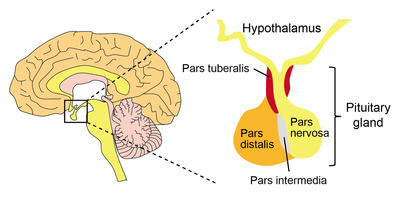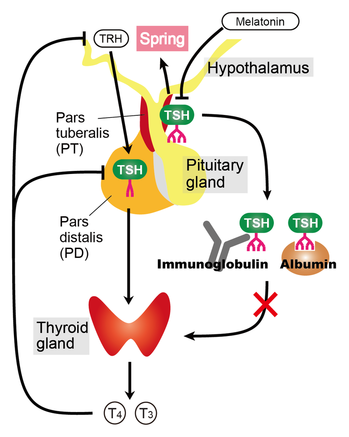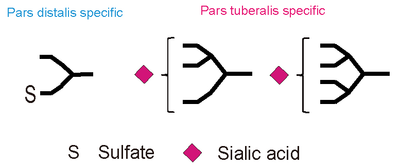Highlights
Highlights
"Longing for spring:" elucidation of the mechanism of survival strategy
- Read in Japanese
- ツイート
- 2015/02/19
- WPI-ITbM
- Graduate School of Bioagricultural Sciences
- Dr. Keisuke Ikegami
- Prof. Takashi Yoshimura
Professor Takashi Yoshimura, Dr. Keisuke Ikegami (currently an assistant professor at Kinki University Faculty of Medicine) and their colleagues at the Institute of Transformative Bio-Molecules (WPI-ITbM) and the Graduate School of Bioagricultural Sciences, Nagoya University, conducting a joint research with Prof. Samuel Refetoff et al. at the Department of Medicine, The University of Chicago, revealed a mechanism to prevent the crosstalk of information between double functional hormones in the blood.
This result was published in Cell Reports on October 30, 2014.→ Nagoya University Press Release
When do bears start to hibernate? How do migratory birds decide their journey? Advancing the research, the whole picture of "springtime hormones" has been uncovered.
In winter, you may feel the need to eat sweets, sleep a lot, or feel a bit low. These symptoms may be also known as seasonal affective disorder (SAD): but why does this occur in winter? If we know the mechanism occurring inside our body, our anxiety will be somehow eliminated.
We know that animals also adapt to seasonal environmental changes; for example, through hibernation, migration of birds, and seasonal breeding without using a calendar. Animals actually recognize the changes in the hours of sun light as their calendar, which means they control something inside their body as a strategy for survival.
Professor Takashi Yoshimura and his research group at the Institute of Transformative Bio-Molecules (WPI-ITbM), Nagoya University, have analyzed the mechanism by which animals "feel the spring."
So far, the research group has discovered the active physiological substance, called the "springtime hormone," that causes the animals to feel the spring. In this study, the complete mechanism by which the substance is regulated inside the body has been revealed.
*******
The hypothalamus and pituitary are the organs that are important in maintaining the body homeostasis, i.e., they control the secretion of a variety of hormones.
The pituitary is the endocrine organ located under the hypothalamus, and it is divided into four parts: pars distalis (anterior lobe), pars intermedia, pars nervosa, and pars tuberalis (Figure 1). In fact, the role of pars tuberalis has only been understood recently.
 Figure 1. The vertical cross-section diagram of the brain, showing the hypothalamus and pituitary. (Figure: by courtesy of Prof. Yoshimura)
Figure 1. The vertical cross-section diagram of the brain, showing the hypothalamus and pituitary. (Figure: by courtesy of Prof. Yoshimura)
"We now know the role of pars tuberalis seen in a particular phenomenon."
In 2008, Prof. Yoshimura and his colleagues reported about the pars tuberalis: "it is the nerve center to convey the seasonal information to the brain" (Nakao, et al. Nature (2008) 452: 317-22, Ono, et al. PNAS (2008) 105: 18238-42).
The pars tuberalis secretes the thyroid-stimulating hormone (TSH) in spring. By acting on the hypothalamus in the brain, we "feel the spring," and term it as the "springtime hormone."
Referring to the TSH, most may think of it as the hormone secreted from the anterior lobe of the pituitary that regulates the body temperature and metabolic activity by stimulating the thyroid. Thus, the springtime hormone has an entirely new function of facilitating the recognition of the "sign of spring" besides the usual function of TSH.
"Despite the same proteins in both TSHs, they act completely differently."
Prof. Yoshimura and Dr. Keisuke Ikegami also in the same research group pointed out that both TSHs secreted from the anterior pituitary and pars tuberalis do not cause a confusion of information despite circulating in the whole body through the blood.
In this phenomenon, creatures must adopt a skillful strategy for survival, occurring inside the body. Understanding the mechanism may help clarify further the mystery.
Dr. Ikegami, first of all, checked the mechanism by which TSHs are controlled inside the body using the laboratory mouse.
The TSH secreted from the anterior pituitary functions as studied in textbooks. Via the hypothalamic thyrotropin-releasing hormone (TRH) secreted from the hypothalamic area, TSH connects with the TSH receptor and promotes the production and secretion of thyroid hormones (T3 as triiodothyronine and T4 as thyroxine). Thereafter, the negative feedback control is activated, suppressing the expression of TSH by thyroid hormones.
On the other hand, the TSH from the pars tuberalis is not controlled by TRH. Instead, it is controlled by the melatonin that regulates the circadian rhythms.
Although these two TSHs have completely different roles, both are still the same proteins and also show the same bioactivity.
"Why is there no confusion regarding the two TSHs?"
Dr. Ikegami monitored TSH secreted into the blood and found out that both TSHs from the anterior pituitary and the pars tuberalis exist together in the blood. Because the two TSHs are not confused in the blood, he hypothesized that the TSH from the pars tuberalis, namely the springtime hormone, stopped the bioactivity when secreted into the blood. As a result, it could not stimulate the thyroid gland. To verify this hypothesis, Dr. Ikegami undertook the next research to check the structure of TSHs.
The amino acid sequences of the two TSH proteins were not different. However, the structure of TSH from the anterior pituitary bound with biantennary N-glycans mainly attached by a sulfate group, whereas the structure of that from the pars tuberalis was a combination of tetra-antennary and triantennary multibranched N-glycans associated with sialic acid (Figure 2). Thus, Dr. Ikegami concluded that the carbohydrate structure (post-translational modifications) was different.
Figure 2. The simplified image of carbohydrate structures bound with TSH. (Figure: by courtesy of Prof. Yoshimura)
"What is the role of the carbohydrate structures in the blood?"
Dr. Ikegami had repeatedly read tens of articles every day, to solve the mystery of his hypothesis. "Although I read many of them, I couldn't find anything what I wanted. I actually couldn't see what I should do at that time," said Dr. Ikegami.
However, he never gave up, and finally found out the answer: he got an inspiration from the "macro-TSH."
Under the supervision of Prof. Yoshimura, he established his original experimental method to solve his hypothesis.
The experimental result revealed an interesting mechanism (Figure 3):
 Figure 3.The mechanism of TSH with double functionalities. (Figure: by courtesy of Prof. Yoshimura)
Figure 3.The mechanism of TSH with double functionalities. (Figure: by courtesy of Prof. Yoshimura)
―Both TSHs from the anterior pituitary and pars tuberalis are secreted into the blood. The TSH from the anterior pituitary stimulates the thyroid gland, whereas that from the pars tuberalis cannot. This is because the sugar chain bound to the TSH from the pars tuberalis is recognized by immunoglobulin and albumin in the blood and the TSH is specifically trapped by them. This trapped TSH forms a complex called the "macro-TSH;" therefore, it cannot stimulate the thyroid gland.―
In this way, the double functionality by the crosstalk of information in the blood can be avoided. It is a survival strategy using limited genomic information.
In the case of humans, patients with macro-TSH (also known as macrothyrotropinemia) may be known with abnormally high blood TSH concentration and normal blood level of thyroid hormones. So far, the reason for the mechanism of macro-TSH has been unknown; however, the research will expectedly progress further in this field also. Dr. Ikegami has now moved to Kinki University Faculty of Medicine as an assistant professor, and is pursuing research in the clinical field.
*******
"How do animals feel seasons?"
The results reported by Dr. Ikegami and Prof. Yoshimura could also expand the discussion with respect to the symptoms in humans. The entire phenomenon and mechanism were revealed because of their hypothesis-driven and discovery-driven approaches.
"Research is not progressing as easily as you expected."
Starting with a hypothesis and the progress of solving it, we increase not only the amount of knowledge but also the number of new discoveries. This is the research, and it is interesting. However, it is essential to be patient and to positively face challenges, as Dr. Ikegami does.
In winter, if you don't feel active,
―just consider being "in the state of animals."
(Ayako Umemura)
Researchers featured in this article
Dr. Takashi Yoshimura【Professor, Institute of Transformative Bio-Molecules (WPI-ITbM), Nagoya University】
 In 1993, Dr. Yoshimura graduated from the School of Agriculture at Nagoya University, and in 1995, he completed his master's course in the Graduate School of Agriculture at Nagoya University. Between April 1995 and September 1996, Dr. Yoshimura pursued his research during his doctoral course as a fellow of the Japan Society for the Promotion of Science (DC1). After the course, he started working as an assistant professor at the same school. In 2005, Dr. Yoshimura became an associate professor at the Graduate School of Bioagricultural Sciences, Nagoya University, and subsequently became a professor in 2008. From 2008 to 2011, Dr. Yoshimura served as a director of the Avian Bioscience Research Center, Nagoya University. In 2013, he started working at the Institute of Transformative Bio-Molecules (WPI-ITbM), Nagoya University. Concurrently, he took on the position of professor at the Graduate School of Bioagricultural Sciences and the position of visiting professor at the National Institute for Basic Biology.
In 1993, Dr. Yoshimura graduated from the School of Agriculture at Nagoya University, and in 1995, he completed his master's course in the Graduate School of Agriculture at Nagoya University. Between April 1995 and September 1996, Dr. Yoshimura pursued his research during his doctoral course as a fellow of the Japan Society for the Promotion of Science (DC1). After the course, he started working as an assistant professor at the same school. In 2005, Dr. Yoshimura became an associate professor at the Graduate School of Bioagricultural Sciences, Nagoya University, and subsequently became a professor in 2008. From 2008 to 2011, Dr. Yoshimura served as a director of the Avian Bioscience Research Center, Nagoya University. In 2013, he started working at the Institute of Transformative Bio-Molecules (WPI-ITbM), Nagoya University. Concurrently, he took on the position of professor at the Graduate School of Bioagricultural Sciences and the position of visiting professor at the National Institute for Basic Biology.
Prof. Yoshimura has received many awards during his career:
Academic Award; Japanese Society for Chronobiology (Nov. 2004);
Japan Prize in Agricultural Sciences, Achievement Award for Young Scientists; The Foundation of Agricultural Sciences of Japan (Nov. 2005);
JSPS Prize; Japan Society for the Promotion of Science (Mar. 2009);
Japanese Society of Animal Science Award (Mar. 2009);
Hoffenberg International Medal; British Endocrine Societies (Mar. 2010);
Fellowship Award; Society of Biology (Britain) (Dec. 2010).
***
"We can research on the achievements of the researchers of the previous years," says Dr. Yoshimura, showing me an anatomy book published 300 years ago and microscopes actually used 100 years ago. Dr. Yoshimura kindly allowed me to look through the lens of the microscope: I felt just like him that it was extremely fascinating.
Currently, Dr. Yoshimura is leading three laboratories. He is really passionate about his work. "I want to work three times more than usual." I expect further achievements from him and from his robust laboratories (by AU)
Dr. Keisuke Ikegami【at that time: Doctorate Student, Research Fellowship for Young Scientists; JSPS (DC1), Graduate School of Bioagricultural Sciences, Nagoya University】
 Dr. Ikegami graduated from the Department of Applied Biological Sciences, School of Agricultural Sciences, Nagoya University, in 2008. In 2010, he began research during his doctoral course at the Graduate School of Bioagricultural Sciences, Nagoya University, as a JSPS DC1. In March 2013, Dr. Ikegami obtained his doctorate degree in Agricultural Sciences. Since April 2013, Dr. Ikegami has started his research as an assistant professor at Kinki University Faculty of Medicine.
Dr. Ikegami graduated from the Department of Applied Biological Sciences, School of Agricultural Sciences, Nagoya University, in 2008. In 2010, he began research during his doctoral course at the Graduate School of Bioagricultural Sciences, Nagoya University, as a JSPS DC1. In March 2013, Dr. Ikegami obtained his doctorate degree in Agricultural Sciences. Since April 2013, Dr. Ikegami has started his research as an assistant professor at Kinki University Faculty of Medicine.
***
Since Dr. Ikegami was a small child, Dr. Ikegami says "I have liked thinking and assembling something from my idea freely using scissors and a ruler" since he was a small child. He has various hobbies, such as drawing pictures and cooking. He told me that research is also his hobby to satisfy himself from curiosity.
After moving to Kinki University, Dr. Ikegami learned a lot of things in the new environment. His excitement influences my soul too. I am looking forward to his further achievements (by AU)
Links
- Institute of Transformative Bio-Molecules (WPI-ITbM) HP http://www.itbm.nagoya-u.ac.jp/
- Laboratory of Animal Physiology HP http://www.agr.nagoya-u.ac.jp/~aphysiol/e-index.html
- Link to this article (from a search-result)
http://www.sciencedirect.com/science/article/pii/S2211124714008602
Keisuke Ikegami, Xiao-Hui Liao, Yuta Hoshino, Hiroko Ono, Wataru Ota, Yuka Ito, Taeko Nishiwaki-Ohkawa, Chihiro Sato, Ken Kitajima, Masayuki Iigo, Yasufumi Shigeyoshi, Masanobu Yamada, Yoshiharu Murata, Samuel Refetoff & Takashi Yoshimura
Tissue-specific posttranslational modification allows functional targeting of thyrotropin.
Cell Reports 9: 801 (2014).
(First published on November 6, 2014; doi:10.1016/j.celrep.2014.10.006)
- Link to related article1 (from a search-result)
http://www.nature.com/nature/journal/v452/n7185/full/nature06738.html
Nobuhiro Nakao, Hiroko Ono, Takashi Yamamura, Tsubasa Anraku, Tsuyoshi Takagi, Kumiko Higashi, Shinobu Yasuo, Yasuhiro Katou, Saburo Kageyama, Yumiko Uno, Takeya Kasukawa, Masayuki Iigo, Peter J. Sharp, Atsushi Iwasawa, Yutaka Suzuki, Sumio Sugano, Teruyuki Niimi, Makoto Mizutani, Takao Namikawa, Shizufumi Ebihara, Hiroki R. Ueda & Takashi Yoshimura
Thyrotrophin in the pars tuberalis triggers photoperiodic response.
Nature 452: 317(2008).
(First published on January 25, 2008; doi:10.1038/nature06738)
- Link to related article2 (from a search-result)
http://www.pnas.org/content/105/47/18238.full
Hiroko Ono, Yuta Hoshino, Shinobu Yasuo, Miwa Watanabe, Yusuke Nakane, Atsushi Murai, Shizufumi Ebihara, Horst-Werner Korf & Takashi Yoshimura
Involvement of thyrotropin in photoperiodic signal transduction in mice.
PNAS. 105: 18238 (2008).
(First published on October 14, 2008; doi: 10.1073/pnas.0808952105)
NU Research
(English)


